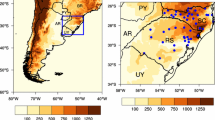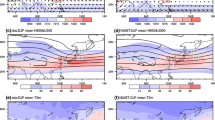Abstract
This study investigates the characteristics of a heavy snowfall event over the southwestern part of the Korean Peninsula on 4 December 2005. The snowstorm was a type of mesoscale maritime cyclone which resulted from barotropic instability, and diabatic heating from the warm ocean in continental polar air masses.
Based on surface observations, radiosonde soundings, MTSAT-1R satellite data and the 10-km grid RDAPS (Regional Assimilation and Prediction System based on the PSU/NCAR MM5) data, the evolution of the mesocyclone is explained by the following dynamics; (1) In the initial stage, the primary role in the cyclogenesis process of the mesocyclone is a barotropic instability in the horizontal shear zone. (2) In the developing stage, the mesocyclone moves and deepens into a baroclinic zone corresponding to the surface heating and moistening. (3) In the mature stage, it is found that the mesocyclone is intensified by the destabilization caused by enhanced low-level heating and condensation, the moisture flux convergence, and the interaction between upper and lower-level potential vorticity anomalies.
We suggest that a checklist with stepwise indicators responsible for development be prepared for the forecasting of heavy snowfall over the southwestern part of the Korean Peninsula.
Similar content being viewed by others
References
Cho, I. H., H. D. Yoo, W. J. Lee, and K. S. Shin, 2004: Analyses of the heavy snowfall event occurred over the middle part of the Korean Peninsula on March 4, 2004 and suggestions for the future forecast. Atmosphere, 14(3), 3–18. (in Korean with English abstract)
Dudhia, J., 1989: Numerical study of convection observed during winter monsoon experiment using a mesoscale two-dimensional model. J. Atmos. Sci., 46, 3077–3107.
Dudhia, J., 1996: A multi-layer soil temperature model for MM5. Preprints, The Sixth PSU/NCAR Mesoscale Model Users’ Workshop, 22–24 July 1996, Boulder, Colorado, 49–50.
Emanuel, K. A., 1994: Sea-air heat transfer effects on extratropical cyclones. Proc. Conf. on the Life Cycles of Extratropical Cyclones, Bergen, Norway, 27 June to 1 July 1994, Amer. Meteor. Soc., 67–72.
Fu, G., H. Niino, R. Kimura, and T. Kato, 2004: A polar low over the Japan Sea on 21 January 1997. Part I: Observational analysis. Mon. Wea. Rev., 132(7), 1537–1551.
Gill, A. E., 1982: Atmosphere-Ocean Dynamics. Academic Press, 662pp.
Heo, K. Y., K. J. Ha, and S. H. Shin, 2005: On development mechanism of heavy snowfall event occurred in Busan on 5 March 2005. Journal of the Korean Meteorological Society, 41(4), 547–556. (in Korean with English abstract)
Holton, J. R., 2004: An Introduction to Dynamic Meteorology. 4th ed, Elsevier Academic Press, 535pp.
Hong, S.-Y., and H.-L. Pan, 1996: Nonlocal boundary layer vertical diffusion in a medium-range forecast model. Mon. Wea. Rev., 124, 2322–2339.
Hoskins, B., M. McIntyre, and A. Robertson, 1985: On the Use and Significance of Isentropic Potential Vorticity Maps. Quart. J. Roy. Meteor. Soc., 111, 877–946.
Kain J. S., and J. M. Fritsch, 1993: Convective parameterization for mesoscale models: The Kain-Fritsch scheme. The Representation of Cumulus Convection in Numerical Models, Meteor. Monogr., K. A. Emanuel and D. J. Raymond, Eds., Amer. Meteor. Soc., 165–177.
Lee, T. Y., Y. Y. Park, and Y. L. Lin, 1998: A numerical modeling study of mesoscale cyclogenesis to the east of the Korean Peninsula. Mon. Wea. Rev., 126(9), 2305–2329.
Ninomiya, K., 1994: A meso-scale low family formed over the northeastern Japan Sea in the northwestern part of a parent Polar low. J. Meteor. Soc. Japan, 72(4), 589–603.
Penc, R. S., 2001: Moisture Analysis of a Type I cloud-topped boundary layer from Doppler radar and rawinsonde observations. J. Atmos. Oceanic Technol., 18(12), 1941–1958.
Reisner, J., R. J. Rasmussen, and R. T. Bruintjes, 1998: Explicit forecasting of supercooled liquid water in winter stroms using the MM5 mesoscale model. Quart. J. Roy. Meteor. Soc., 124B, 1071–1107.
Seo, E. K., and J. G. Jhun, 1991: A case study of the heavy snowfalls occurred in the Korean Peninsula from 29 January to 1 February 1990. Journal of the Korean Meteorological Society, 27(2), 165–179. (in Korean with English abstract)
Xu, Y., and M. Zhou, 1999: Numerical simulations on the explosive cyclogenesis over the kuroshio current. Adv. Atmos. Sci., 16(1), 64–76.
Yanase, W., G. Fu, H. Niino, and T. Kato, 2003: A Polar Low over the Japan Sea on 21 January 1997. Part II: A Numerical Study. Mon. Wea. Rev., 132(7), 1552–1574.
Yih, A. C., and J. E. Walsh, 1991: Sensitivities of numerical model forecasts of extreme cyclone events. Adv. Atmos. Sci., 8(1), 51–66.
Author information
Authors and Affiliations
Corresponding author
Rights and permissions
About this article
Cite this article
Heo, KY., Ha, KJ. Snowstorm over the southwestern coast of the Korean Peninsula associated with the development of mesocyclone over the Yellow Sea. Adv. Atmos. Sci. 25, 765–777 (2008). https://doi.org/10.1007/s00376-008-0765-2
Received:
Revised:
Published:
Issue Date:
DOI: https://doi.org/10.1007/s00376-008-0765-2




